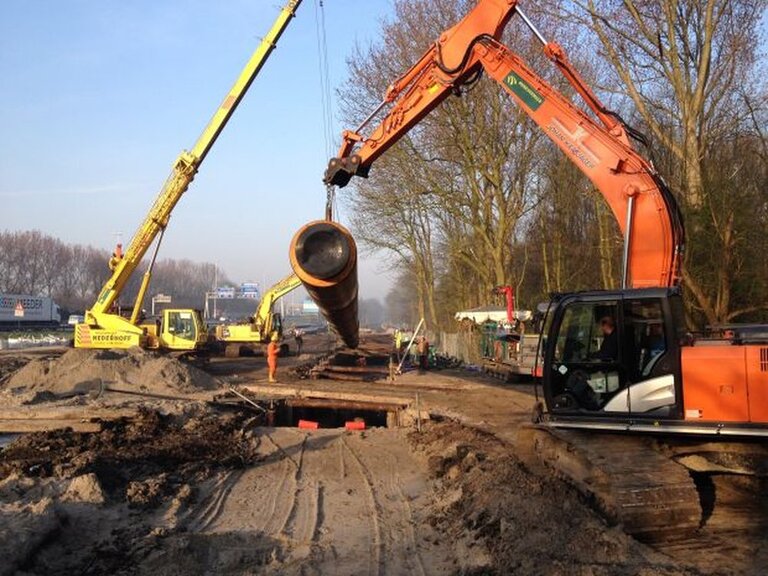From 2023, residual heat from the Port of Rotterdam will go via a large pipeline to The Hague and all intermediate municipalities, including greenhouse horticulture. Bilfinger Tebodin is closely involved in the detail engineering of this ‘Pipeline through the Middle’.
With its sizeable petrochemical industry and the NV Waste Processing Rijnmond (AVR), the Port of Rotterdam has enormous potential in residual heat. No wonder that the province of Zuid-Holland wants to build a regional heat network. The Port of Rotterdam Authority, Eneco, Gasunie, the municipality of Rotterdam and the Ministry of Economic Affairs also support this plan. After all, residual heat is an important alternative to natural gas.
The Rotterdam region already has two heat networks. The ‘Nieuwe Warmteweg’ is 26 kilometers long and connects AVR in Rozenburg with 50,000 homes in Rotterdam South. The 16.8 kilometer long ‘Leiding over Noord’ serves 95,000 households in Vlaardingen and Schiedam.
Bilfinger Tebodin
From 2023 onwards, the ‘Pipeline through the Middle’ will connect to this. This pipeline is 23 kilometers and runs from the Vondelingenplaat (Port of Rotterdam) to the heat/power plant of Uniper in The Hague. Not only The Hague will benefit from this residual heat, but in the future possibly also Vlaardingen, Schiedam, Midden-Delfland, Delft and Rijswijk. This concerns 80,000 to 100,000 homes, plus a large number of greenhouse horticultural businesses in the Westland. Gasunie will construct the pipeline at the request of the Ministry of Economic Affairs and will become the independent heat transport manager upon completion.
Consultancy and engineering firm Bilfinger Tebodin has been working on detail engineering of a large part of the route since June 2019, says project manager Edwin Meijer of the Pipelines department in Schiedam. 'That means that we make all specification drawings and strength calculations. This specification is essential for future contractors. The drawings and calculations are also required for permit applications from Rijkswaterstaat, the water board and the province, among others. These governments must issue permits for this pipeline. For example, when crossing a motorway or structure, Rijkswaterstaat wants to know in detail what the dimensions and the materials used are, but also whether the strength calculations meet the standards and guidelines. There is also still a lot of consultation with municipalities, road authorities and other stakeholders.'
In the detail design, Bilfinger Tebodin indicates where all underground cables and pipes, works of art, highways and railways are located. Meijer: 'So that the contractor knows exactly where to dig and where to drill.'
Densely populated area
According to Meijer, the ‘Pipeline through the Middle’ is a complex logistics project. 'Construction is in a densely populated area. We cross various roads, flood defenses and (metro) railway lines. In addition, there is soft peaty soil between Vlaardingen and Delft, while there must be a temporary construction road for the supply and removal of soil and building material.'
The ‘Pipeline through the Middle’ consists of two steel pipelines, a supply and return pipe, with an internal diameter of 700 mm to The Hague South, then 600 mm and 500 mm. Polyurethane foam and PE (polyethylene) are added for insulation and protection. Long bores are made in steel-in-steel. Meijer: 'The piping system is designed at a supply temperature of 120 degrees Celsius and a return temperature of 70 degrees Celsius. The design pressure is 25 bar.'
According to the project manager, the connection to the existing ‘Leiding over Noord’ will not experience any problems. 'By installing tees and valves, the pipe manager at the time has already taken the branch to the ‘Pipeline through the Middle’ into account. We also take possible future branches and extensions into account in our detail design. For example, there will be a branch for glasshouse horticulture in Delft.'
Bilfinger Tebodin is currently working on the project with approximately seven people from the Pipelines department. 'We are currently busy finalizing the detail engineering. After that, we will of course remain involved in the project, for example for support during implementation.'
‘Pipeline through the Middle’
- Length: 21 kilometers;
- Capacity: 250 MW;
- Diameter (internal): 700/600/500 mm;
- Diameter (external): 900/800/700 mm;
- Investment: €140 million
The article published in Dutch media: https://www.technischweekblad.nl/artikelen/tech-achtergrond/bilfinger-tebodin-zit-er-warmpjes-bij


